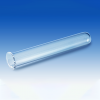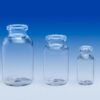At Technical Glass Products (TGP), our mission is to deliver glass solutions that meet the highest standards for purity, durability, and performance. One material that embodies these values remarkably is quartz glass. In this post, we explore why quartz glass is a critical component in water purification applications—how it’s used, what makes it ideal, and how TGP’s expertise ensures systems deliver clean, reliable water for industries, municipalities, and research.
What Is Quartz Glass?
Quartz glass—also known as fused silica—is a high-purity, amorphous silica material formed by melting natural or synthetic quartz crystals. Unlike many conventional glasses (which are silica-based but include significant quantities of other oxides), quartz glass is nearly pure silica. This composition gives it exceptional thermal, chemical, and optical properties, making it the material of choice when performance cannot be compromised.
Key properties include:
- High transparency deep into the UV spectrum.
- Extreme purity, with very low levels of dissolved ions and particulates.
- Thermal stability, resisting expansion, deformation, or devitrification under rapid temperature changes.
- Chemical inertness, resisting attack from acids, bases, and oxidizing agents.
These properties make quartz glass uniquely suited to many stages of water purification.
Why Water Purification Needs Premium Materials
Purifying water—whether for drinking water, industrial processes, semiconductor production, or laboratory use—is not simply about removing salts or visible turbidity. High-performance purification involves:
- Eliminating microorganisms.
- Destroying organic contaminants (e.g. by UV light).
- Handling extreme pH waters.
- Operating at varying temperatures, sometimes including boiling or very cold conditions.
- Avoiding introduction of new contaminants from the apparatus itself.
Any material used in contact with the water or in the optical path for disinfection must not leach impurities, discolor under UV exposure, or degrade under harsh chemical or thermal stress.
Where Quartz Glass Serves in Water Purification Applications
Below are key application areas in which quartz glass plays a critical role:
| Application | Role of Quartz Glass | Why Quartz Glass Is the Best Choice |
| UV Disinfection Chambers | Quartz glass is used as sleeves or windows, covering UV lamps that emit high-energy ultraviolet light to kill or deactivate bacteria, viruses, and other microorganisms. The glass must allow UV-C light (~200-280 nm) to pass while maintaining mechanical integrity. | Quartz glass transmits deep UV far better than ordinary silica glass, and retains that transmission over time without yellowing. Its purity prevents UV absorption and ensures clean, efficient disinfection. |
| Photolytic Treatment Systems | Some advanced purification systems use photolysis to degrade organic compounds. Quartz windows or enclosures are used to allow UV or other specific wavelengths through. | Again, the high UV transparency and resistance to UV-induced damage make quartz ideal. |
| Analytical Equipment & Sensors | Instruments measuring water quality (e.g., spectrophotometers) often require optical windows or cells made from quartz to ensure accurate transmission and minimal background errors. | Quartz’s low auto-absorbance and stable absorption spectrum provide consistency over long use. |
| High-Temperature Treatment or Sterilization | Systems that subject water to extreme heat, sometimes in steam sterilization or thermal regeneration, use quartz components because they withstand repeated thermal cycling without cracking or warping. | Quartz has very low coefficient of thermal expansion, meaning it does not expand or contract much as temperatures change, reducing risk of mechanical failure. |
| Acid/Base Resistant Components | In purification steps that use aggressive chemicals (flocculation, pH correction, acid or base washes), quartz parts may be needed to avoid corrosion or contamination. | Quartz is resistant to many chemicals; it does not leach metals or degrade under harsh chemical attack. |
How TGP Ensures Excellence in Every Quartz Glass Component
At Technical Glass Products, we don’t just offer “quartz glass”; we supply engineered components that meet the rigorous demands of water purification systems. Here’s how:
- Material Sourcing & Purity Control
We source high-grade fused silica with minimal impurities. We monitor trace metals, hydroxyl groups, and defect densities to ensure UV transmission and chemical inertness. - Precision Fabrication
Whether you need tubes, windows, custom sleeves, UV protective enclosures, or optical cell parts, our fabrication process—including grinding, polishing, drilling, and annealing—is carefully controlled. Surface finish and geometric tolerances matter: even minor defects can reduce UV transmission or promote stress cracks. - Thermal & Mechanical Stress Testing
We subject parts to repeated thermal cycling, pressure variation, and stress simulations to ensure durability in real-world water treatment scenarios. - Custom Design & Integration
We work with OEMs, system integrators, municipalities, and laboratories to design parts that integrate seamlessly into purification systems—matching lamp geometries, sensor locations, flow dynamics, and maintenance access. - Quality Assurance & Regulatory Compliance
Our parts are made to standards appropriate for potable water or industrial process use. We maintain clean manufacturing environments and often test for leachables, biocompatibility, and performance in UV exposure over time.
Case Study: UV Disinfection System Upgrade
To illustrate, consider a municipal water treatment plant upgrading its UV disinfection stage. The plant previously used standard quartz sleeves around UV lamps and found over time that UV output dropped significantly—caused by gradual deposition, yellowing, and mechanical stress through thermal cycles. Working with TGP, the plant installed sleeves made from high-purity fused silica with improved surface polish. As a result:
- UV intensity rebounded to near original levels.
- Maintenance frequency dropped because the quartz resisted fouling and thermal breakage better.
- Overall energy usage dropped, since less UV lamp power was needed to achieve the required dosages.
Looking Forward: Innovations & Emerging Needs
The water purification field is evolving. Some emerging trends where quartz glass is increasingly critical:
- Higher UV dosages for emerging pathogens, micropollutants, and viral threats.
- Compact, distributed purification systems, sometimes solar powered or field-deployable, that still need high durability and reliability in harsh conditions.
- Advanced photochemical and photocatalytic systems requiring broader UV or specific spectral windows.
- Real-time, inline sensors for contaminants where optical materials must both protect sensors and not interfere with measurement.
At TGP, we are investing in research into ultra-low hydroxyl fused silica, coatings that resist fouling without suppressing UV transmission, and designs that ease maintenance without compromising performance.
How to Engage TGP for Your Quartz Glass Needs
If your purification system relies on UV light, experiences issues with component degradation, or if you’re innovating in water treatment, we can help. Whether you need off-the-shelf quartz windows and sleeves or fully custom engineered components, our team at Technical Glass Products is equipped to deliver solutions that maximize purity, performance, and longevity.
Contact us to discuss specifications, sample orders, or material qualification testing. Let TGP be your partner in achieving water quality that meets both regulatory standards and peace of mind.







